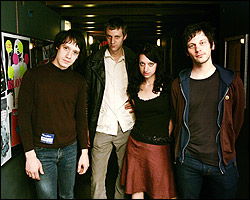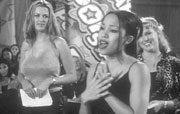- John Cale, Tony Conrad, Angus MacClise, La Monte Young, Marian Zazeela (aka Theater of Eternal Music), Inside the Dream Syndicate Volume 1: Day of Niagara (Table of Elements; 2000).
- John Cale, “Antarctica Starts Here” (Reprise; 1973).
- Lou Reed, “Street Hassle” (Arista; 1978).
- Nico, “Evening of Light” (Elektra; 1969).
- Roxy Music,”Chance Meeting” (Virgin; 1972).
- Patti Smith, “Birdland” (Arista; 1975).
- The Stooges, “We Will Fall” (Elektra/WEA; 1969).
- Iannis Xenakis, “Okho” (Mode; 1996).
- Terry Riley, “The Gift” (Organ of Corti; 1998).
- Faust, “Just a Second (Starts Like That)” (Virgin; 1973).
Forget choosing your favorite Beatle. Who’s your favorite Velvet? Better yet, let me just tell you mine: John Cale. I don’t connect with much of his current work (the unbelievably tepid single “Perfect,” from his recent blackAcetate on Astralwerks, renders Lou Reed’s horrid “Like a Possum,” from 2000’s Ecstasy, downright listenable), but his beginnings—screwing with the viola and his proper classical training while mapping out minimalist avant-drone noise with guys like La Monte Young, Iannis Xenakis, Aaron Copeland, and that other John (Cage)—make all the pleasing pop stuff that came out in VU and afterward that much more intriguing.
Hence the first two songs; contrast the droning, awesomely inelegant 30 minutes of proto- minimalist experimenting from 1965 with the achingly beautiful three-minute track (based on the movie Sunset Boulevard) from Paris 1919. Then, for evidence that Cale is the alpha Velvet, check Reed’s urban-epic title track from 1978’s Street Hassle. It’s one of my favorite songs of all time and definitely better than anything from Cale’s 1975 Slow Dazzle. All you need to do is compare cover art (and album titles) to see that Reed was clearly copping Cale’s shtick and trying to play catch-up.
From there the mix spotlights some of Cale’s production work. He probably understood Nico and Smith like no one else, and if he was an odd match for the Stooges, “We Will Fall” is one of the songs that would’ve been harder to pull off if Iggy and company had teamed with a more textbook-y garage/punk producer. Next you get a few of Cale’s associates and an associate of an associate. Cale worked with Tony “Eternal Music” Conrad, who in turn collaborated with German industrial-ambient punks Faust. The common thread—pushed first through the fabric of experimental, mostly minimalist exo-song structures when Cale ditched the conservatories and wormed his way into the avant-garde—connects punks, pop stars, sound artists, modern and traditional composers, and junk collectors from around the world. It’s not so much that Cale is responsible for it all as that his ear stitches together a brilliant assortment of musicians that, if all of them were in a room, would make for a pretty fantastic party.
Because most of this stuff doesn’t fit inside a three-minute pop song, and because of the similarly restrictive boundaries of a CD-R, this mix consists of long tracks and too few of them. I’d love to see The Wire do a big six-degrees chart on Cale the way the glossy entertainment mags do for Britney and Madonna—or better yet, I should just make a box set.
Oh, and for the record, my favorite Beatle is Yoko.







